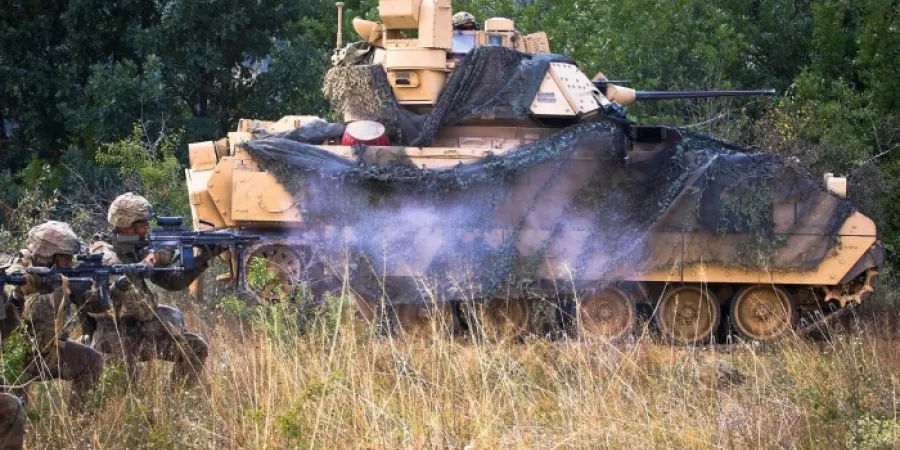Elbit, Rafael among final contenders for US Army future fighting vehicle project
The US Army has selected five finalists in the bidding for the production and supply of the future Optionally Manned Fighting Vehicle. BAE has teamed up with Elbit America, and Oshkosh has teamed up with Rafael. The Army is estimated to have about 3,800 Bradley vehicles
Eyal Boguslavsky
| 27/07/2021
The U.S. Army has selected five teams to develop designs for the replacement of its Bradley Infantry Fighting Vehicle. Point Blank Enterprises, Oshkosh Defense, BAE Systems, General Dynamics Land Systems and American Rheinmetall Vehicles are to conjure up rough digital concept designs for the Optionally Manned Fighting Vehicle (OMFV). The total award value for all five contracts is approximately $299.4 million, according to the Defense News website.
BAE Systems announced that along with teammate Elbit Systems of America, they will explore crew automation, active protection, and other transformational combat vehicle technologies and turret solutions that will deliver the advanced warfighting capabilities the Army needs for the future, the report said.
Oshkosh will work with South Korean defense company Hanwha and Rafael Advanced Defense Systems. The team is to offer an up-to-date OMFV design based on the chassis of the Redback IFV developed by Hanwha, with a weapon station provided by Rafael. The Redback is one of two contenders for the LAND 400 Phase 3 project designed to introduce next-generation tracked armored IFVs for the Australian Army.
The Rheinmetall team also includes Raytheon Technologies, Textron and L3Harris Technologies. Point Blank is the only small company to win a contract. Mettle Ops had also submitted a bid to design an OMFV concept, and Roush Defense is also believed to have bid.
Defense News also reported that the service plans to spend $4.6 billion from fiscal 2022 through fiscal 2026 on the OMFV. Over the course of the next 15 months, the teams will take their initial concepts, share them with the government and begin a back and forth dialogue. Following the concept design phase, the Army will move into a detailed design phase, through another full and open competition, that will be executed over the course of FY23 and FY24.
Awards for up to three contracts are expected in the second quarter of FY23. The prototyping phase will begin in FY25 and vehicle testing will begin in FY26 and wrap up the following year with a production decision planned for the fourth quarter of FY27. Full-rate production is expected to begin in the second quarter of FY30, according to the report.
The US Army has selected five finalists in the bidding for the production and supply of the future Optionally Manned Fighting Vehicle. BAE has teamed up with Elbit America, and Oshkosh has teamed up with Rafael. The Army is estimated to have about 3,800 Bradley vehicles
The U.S. Army has selected five teams to develop designs for the replacement of its Bradley Infantry Fighting Vehicle. Point Blank Enterprises, Oshkosh Defense, BAE Systems, General Dynamics Land Systems and American Rheinmetall Vehicles are to conjure up rough digital concept designs for the Optionally Manned Fighting Vehicle (OMFV). The total award value for all five contracts is approximately $299.4 million, according to the Defense News website.
BAE Systems announced that along with teammate Elbit Systems of America, they will explore crew automation, active protection, and other transformational combat vehicle technologies and turret solutions that will deliver the advanced warfighting capabilities the Army needs for the future, the report said.
Oshkosh will work with South Korean defense company Hanwha and Rafael Advanced Defense Systems. The team is to offer an up-to-date OMFV design based on the chassis of the Redback IFV developed by Hanwha, with a weapon station provided by Rafael. The Redback is one of two contenders for the LAND 400 Phase 3 project designed to introduce next-generation tracked armored IFVs for the Australian Army.
The Rheinmetall team also includes Raytheon Technologies, Textron and L3Harris Technologies. Point Blank is the only small company to win a contract. Mettle Ops had also submitted a bid to design an OMFV concept, and Roush Defense is also believed to have bid.
Defense News also reported that the service plans to spend $4.6 billion from fiscal 2022 through fiscal 2026 on the OMFV. Over the course of the next 15 months, the teams will take their initial concepts, share them with the government and begin a back and forth dialogue. Following the concept design phase, the Army will move into a detailed design phase, through another full and open competition, that will be executed over the course of FY23 and FY24.
Awards for up to three contracts are expected in the second quarter of FY23. The prototyping phase will begin in FY25 and vehicle testing will begin in FY26 and wrap up the following year with a production decision planned for the fourth quarter of FY27. Full-rate production is expected to begin in the second quarter of FY30, according to the report.



